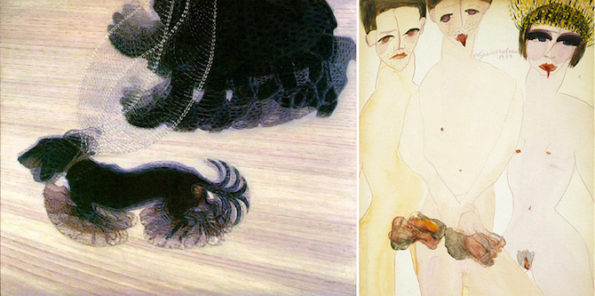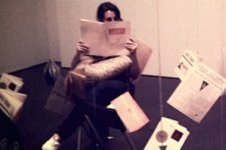Search
To search for an exact match, type the word or phrase you want in quotation marks.
A*DESK has been offering since 2002 contents about criticism and contemporary art. A*DESK has become consolidated thanks to all those who have believed in the project, all those who have followed us, debating, participating and collaborating. Many people have collaborated with A*DESK, and continue to do so. Their efforts, knowledge and belief in the project are what make it grow internationally. At A*DESK we have also generated work for over one hundred professionals in culture, from small collaborations with reviews and classes, to more prolonged and intense collaborations.
At A*DESK we believe in the need for free and universal access to culture and knowledge. We want to carry on being independent, remaining open to more ideas and opinions. If you believe in A*DESK, we need your backing to be able to continue. You can now participate in the project by supporting it. You can choose how much you want to contribute to the project.
You can decide how much you want to bring to the project.

Something is going on at MACBA. In appearance everything is as normal, the skaters doing their acrobatic stunts on the ramps, huddles of adolescents, milling around in small groups as if the rest of the world was nothing to do with them, the odd foreigner looking slightly dazed, moving like a fawn in the middle of the road, not knowing if its better to come or go…and from the outside, the Meier building continues as immaculate as ever, flaunting with pride its aseptic, spotless appearance. But if we delve a little deeper into its entrails, we discover with perplexity, that the white cube has seen itself abruptly interrupted by a room in which the walls have been stained dark, garnet red, and where the cold, neutral lighting of LEDs has given way to an intimate atmosphere, that few would relate to “your average contemporary art museum”. It is the main room showing the exhibition of the appassionata artist Carol Rama, in which, moreover, for the first time in ages the interminable explanatory vinyl texts on the walls have ceded prominence to the images, allowing the works to talk for themselves. Sight has won (at least this time) over logos.
Now I remember that in February this year , Bartomeu Marí already expressed his intention to carry out a “reset” regarding the formats and contents of MACBA. An authentic “revolution”. In fact, this very exhibition is framed within one of the new lines of investigation that were presented for the period 2014-2016 (“The Political Body”, with which the aim is to analyse the relations between art, bio-political production and emancipation; and “Heterodox Histories”, that pursues the visualization of dissident narratives). So in effect something is changing at MACBA.
The Rama show is not your everyday exhibition. And I have to admit that I feel a special predilection for the singular red room. The first watercolours by the artist are shown there, in which it is no longer the innocent dog of Giacomo Balla that wags its tail, so much as others that are doing the wagging with a similar joy, exhibiting a sexual freedom not easily tolerated in the Fascist Italy where they were made. An Italy, where openly misogynist movements such as Futurism had, almost effortlessly, gained success. On the other hand, and in the face of the hegemony that for centuries had flaunted a gaze that relegated women to mere virginal subjects, docile, passive and malleable in the face of the sexual desires of men, -and which debased homosexual behaviour and orientation -, in these first works, Carol Rama audaciously presented both men and women ripping the snake of original sin from their anuses and vaginas with a lewd gesture, vindicating power. (“I didn’t have any painters as my master. The sense of sin is my master”).
Not aiming to give lessons to anybody, so much as a form of personal catharsis, she launched an audacious and impudent attack on many of the fictions that had constructed an idea of feminine and masculine stereotypes far from the complex diversity of bodies and real psyches, she exhibited elements usually kept invisible, such as pubic hair, male perianal hair, and a long list of etc. In her time it just didn’t wash. She was branded pornographic and ignored during many years by a large group of critics and historians. Her marked, temperamental character, that reminds me so much of a fellow citizen of mine and his metaphysical boxes, world weary and capable of saying what ever came in to her head at the most inopportune moment, perhaps didn’t help to improve the panorama. And yet, today MACBA has decided to wager on her again and I can do nothing but be cheered by this and thankful. It would seem therefore that there would be nothing left to be said. Period. I switch off the computer and head off. But all things considered I’m left with a slightly bittersweet aftertaste because ultimately, even though something has happened, I still don’t really sense the announced revolution.
Up to what point have the changes been transcendental? Can we celebrate that the institution has finally managed to reconcile and reconnect with the society to which it belongs? The red colour of the room perhaps constitutes a slightly premonitory response. Since Pompeii, passing through the villas of bourgeois collectors, the rooms of the Vatican or palace saloons, red is the colour of the select minorities. And unfortunately, the exhibition of Carol Rama continues to be a show that will be visited, understood and valued by only a specific bubble of people, far removed from your average man on the street. The world of contemporary art will self-congratulate itself with pats on the back, but meanwhile, the message still won’t have the slightest impact on society.

Despite the numerous efforts carried out to dismantle the traditional social fictions that have underlined bodies and minds during centuries, works such as those of this author will continue to represent minority imaginaries, incapable of opposing the prevailing norm. Fredric Jameson made the following argument in his book Archaeologies of the future: “Marcuse sustains that it is the very separation between art and culture on the one hand and the social on the other (…) which constitutes the source of the incorrigible ambiguity of art. Because this very distance with regard to its social context, which allows it to function as a critique and indictment of the latter, also dooms its interventions to ineffectuality and relegates art and culture to a frivolous, trivialised space in which such intersections are neutralised in advance.” I don’t entirely agree. I don’t think we should throw in the towel. But perhaps the hour has come to go a step further. Small signs of change shouldn’t be enough for us. Perhaps it’s the moment for all the agents involved in the world of art (artists, critics, students, museums, curators, teachers, historians…) to carry out a profound reflection on the real transcendence of contemporary artistic imaginaries socially and the efficiency of the tactics employed to communicate and have an impact on society.

Those who know Amaia well, call her affectionately “la contreras”. For she spends hours, as if she has time to spare, debating, thinking and rethinking, analysing, deducing, responding…There are even those how have caught her in fraganti disagreeing with her pencil, in the margins of the pages, with the author of this book that by chance has landed in her hands. It was just a question of time before she ended up writing her own reflections in the hope that at some point somebody would read her ruminations, pencil in hand.
"A desk is a dangerous place from which to watch the world" (John Le Carré)